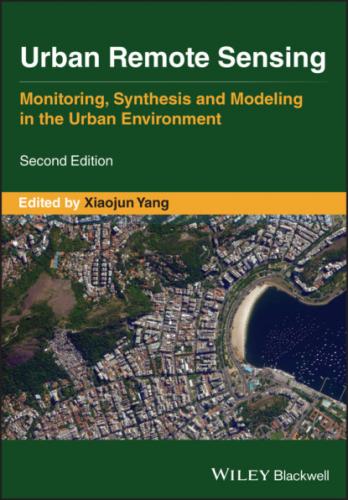1.4 SUMMARY AND CONCLUDING REMARKS
This chapter has discussed the rationale and motivation leading to the publication of this new edition on urban remote sensing. Then, it has provided an overview on some essential and emerging areas that are shifting the directions in urban remote sensing research over the past decade, followed by a preview of the book structure and the major topics covered in the book.
While exciting progress has been made in urban remote sensing during the past ten years, as discussed in this new edition, there are several major conceptual or technical areas deserving further attentions. Firstly, while a clear transition in urban remote sensing research from being technologically driven into being problem‐solving motivated has been observed, we herewith call for a systematic consideration of all components in a project, conceptual or technical, in order to obtain the best possible outcome. Secondly, urban remote sensing research has been shifting beyond observing physical patterns and into understanding underlying processes, and into pursuing toward urban sustainability. To accommodate this transformation, urban remote sensing researchers should be equipped with not only solid technical skills for monitoring, analysis, and modeling but also essential knowledge on cities including relevant core concepts, theoretical debates, and emerging methods. Thirdly, there has been an increasing trend for an urban remote sensing project to use data from diverse sources including not only multi‐temporal and multi‐sensor images but also big geotagged data from social sensing. It is important to maintain and probably strengthen research efforts in developing practical methods that can help derive reliable information from diverse and heterogenous datasets. Last, more efforts should be made in urban remote sensing education to train the next generation of interdisciplinary scientists who not only can develop essential knowledge to understanding cities but also link knowledge to action in search of a transition towards urban sustainability.
REFERENCES
1 Arévalo, P., Olofsson, P. and Woodcock, C.E., 2019. Continuous monitoring of land change activities and post‐disturbance dynamics from Landsat time series: a test methodology for REDD+ reporting. Remote Sensing of Environment. DOI: https://doi.org/10.1016/j.rse.2019.01.013.
2 Berland, A. and Lange, D.A., 2017. Google Street View shows promise for virtual street tree surveys. Urban Forestry and Urban Greening, 21: 11–15.
3 Bhatta, B., 2010. Analysis of Urban Growth and Sprawl from Remote Sensing Data. Springer, 172p.
4 Bonafoni, S., Baldinelli, G. and Verducci, P., 2017. Sustainable strategies for smart cities: analysis of the town development effect on surface urban heat island through remote sensing methodologies. Sustainable Cities and Society, 29: 211–218.
5 Cai, J., Huang, B. and Song, Y., 2017. Using multi‐source geospatial big data to identify the structure of polycentric cities. Remote Sensing of Environment, 202: 210–221.
6 Chen, B., Huang, B. and Xu, B., 2015. Comparison of spatiotemporal fusion models: a review. Remote Sensing, 7(2): 1798–1835.
7 Chen, T‐H. K, Qiu, C., Schmitt, M., Zhu, X. X., Sabel, C. E. and Prishchepov, A.V., 2020. Mapping horizontal and vertical urban densification in Denmark with Landsat time‐series from 1985 to 2018: a semantic segmentation solution. Remote Sensing of Environment, 251: 112096. DOI: org/10.1016/j.rse.2020.112096.
8 Corbane, C., Pesaresi, M., Politis, P., Syrris, V., Florczyk, A.J., Soille, P., Maffenini, L., Burger, A., Vasilev, V., Rodriguez, D. and Sabo, F., 2017. Big earth data analytics on Sentinel‐1 and Landsat imagery in support to global human settlements mapping. Big Earth Data, 1(1–2): 118–144.
9 Costanzo, A., Montuori, A., Silva, J., Silvestri, M., Musacchio, M., Doumaz, F., Stramondo, S. and Buongiorno, M., 2016. The combined use of airborne remote sensing techniques within a GIS environment for the seismic vulnerability assessment of urban areas: an operational application. Remote Sensing, 8(2): 146.
10 Dodge, M., 2018. Mapping II: news media mapping, new mediated geovisualities, mapping and verticality. Progress in Human Geography, 42(6): 949–958.
11 Du, P., Xia, J., Zhang, W., Tan, K., Liu, Y. and Liu, S., 2012. Multiple classifier system for remote sensing image classification: a review. Sensors, 12(4): 4764–4792.
12 Errico, A., Angelino, C.V., Cicala, L., Persechino, G., Ferrara, C., Lega, M., Vallario, A., Parente, C., Masi, G., Gaetano, R. and Scarpa, G., 2015. Detection of environmental hazards through the feature‐based fusion of optical and SAR data: a case study in southern Italy. International Journal of Remote Sensing, 36 (13): 3345–3367.
13 Fan, C., Myint, S.W., Rey, S.J. and Li, W., 2017. Time series evaluation of landscape dynamics using annual Landsat imagery and spatial statistical modeling: evidence from the Phoenix metropolitan region. International Journal of Applied Earth Observation and Geoinformation, 58: 12–25.
14 Gamba, P. and Herod, M. (eds.) 2009. Global Mapping of Human Settlement: Experiences, Datasets, and Prospects. CRC Press, 374p.
15 Gorelick, N., Hancher, M., Dixon, M., Ilyushchenko, S., Thau,
